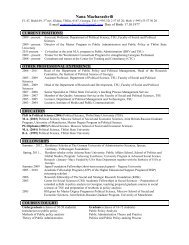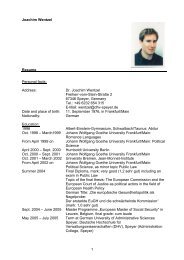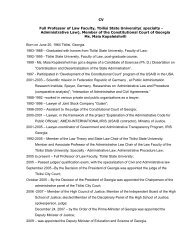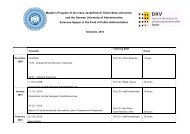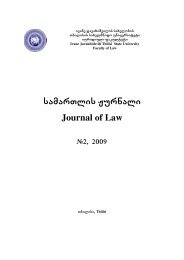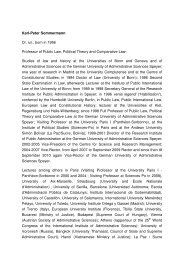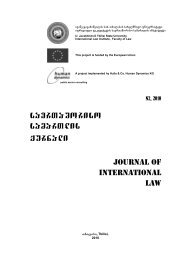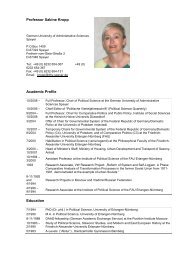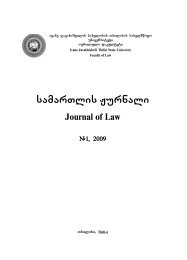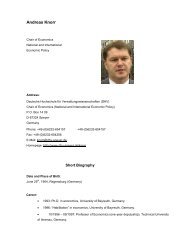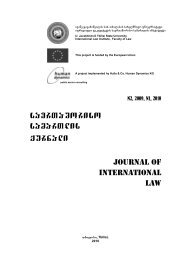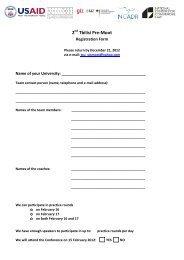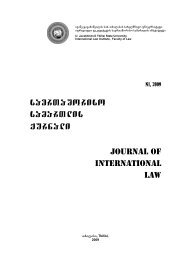Untitled
Untitled
Untitled
Create successful ePaper yourself
Turn your PDF publications into a flip-book with our unique Google optimized e-Paper software.
saerTaSoriso samarTlis Jurnali, #1, 2008 JOURNAL OF INTERNATIONAL LAW, N1, 2008<br />
spectively, shooting down by a fighter of a foreign<br />
state of the unmanned (spy) plane of the<br />
Ministry of Interior of Georgia does without any<br />
doubt constitute a use of armed force against<br />
the Georgian state territory and correspondingly<br />
this constitutes the act of aggression, as<br />
defined by the Article 3 (b) of the 1974 United<br />
Nations General Assembly Resolution.<br />
3.3. Relevance of the Use of<br />
the Right of Self-defense<br />
According to the Article 51 of the United<br />
Nations Charter, a Member of the United Nations<br />
possesses the inherent right of self-defense<br />
if an armed attack occurs against it.<br />
According to the mentioned article, resorting<br />
to armed forces for the purpose of self-defense<br />
is permitted until the Security Council<br />
has taken measures necessary to maintain<br />
international peace and security. In case of<br />
using the right of self-defense, the state is<br />
obliged to immediately report to the Security<br />
Council on the measures taken by it in the<br />
exercise of the right of self-defense. However<br />
it must be mentioned that even though the<br />
armed attack automatically triggers the right<br />
to act contrary to the principle established by<br />
the Article 2(4) of the UN Charter (i.e. the principle<br />
of prohibition of use of force), the violation<br />
of the mentioned paragraph is not always<br />
qualified as an armed attack within the meaning<br />
of the Article 51 of the Charter. 12 An armed<br />
attack, as provided for in the Article 51, is exercised<br />
only when the armed force is used in<br />
a relatively wide scale, inflicting the substantial<br />
outcomes (simple accidents at the state<br />
boundaries, such as for example, crossing by<br />
a border patrol police of a state the border<br />
line of another state will be considered a violation<br />
of Article 2(4), but not an armed attack<br />
within the meaning of the Article 51). 13 It must<br />
be mentioned that according to a Commentary<br />
to the United Nations Charter, the acts of<br />
aggression provided for in the 1974 United<br />
Nations General Assembly Resolution (including<br />
an act envisaged by the above mentioned<br />
Article 3(b)) may be considered as an instance<br />
of an armed attack, as provided for in the Article<br />
51. 14 Correspondingly, if a state uses an<br />
armed force against the territory of another<br />
state, an injured state may claim to use the<br />
right of self-defense as provided for by the<br />
Article 51 of the United Nations Charter.<br />
3.4 Chapter VII of the United Nations<br />
Charter – the Actions with respect to<br />
Threats to the Peace, Breaches of the<br />
Peace and Acts of Aggression (Art. 39-51)<br />
According to the Article 39 of the Unted<br />
Nations Charter, the Security Council shall<br />
determine the existence of any threat to the<br />
peace, breach of the peace, or act of aggression<br />
and shall decide what measures shall be<br />
taken in accordance with Articles 41 and 42,<br />
to restore or maintain international peace and<br />
security.<br />
The Security Council, acting within the<br />
contecxt of the Article 39, when establishing<br />
an act of aggression, uses the definition as<br />
provided for by the UN General Assembly. 15<br />
However, establishing an act of aggression by<br />
the Security Council within the meaning of the<br />
Article 39 represents a political decision and<br />
there have been cases when the Security<br />
Council have not recognized certain short<br />
term armed activities as aggression. 16<br />
In case of establishing a threat to the<br />
peace, breach of the peace and the act of<br />
aggression, in accordance with the Article 41,<br />
the Security Council may decide to undertake<br />
measures not involving the use of armed force<br />
and it may call upon the Members of the United<br />
Nations to apply such measures (for example,<br />
interruption of econoic relations and<br />
of rail, air, sea, and postal communication;<br />
severance of diplomatic relations).<br />
If the measures provided for in Article 41<br />
prove to be inadequate, the Security Council<br />
may, in accordance with the Article 42, take<br />
such action by air, sea, or land forces as may<br />
be necessary to restore international peace<br />
and security.<br />
However, it must also be taken into consideration<br />
that according to the Article 27 of<br />
the United Nations Charter the Security Council<br />
makes a decision by a majority of affirmative<br />
vote (of minimum 9 members), including the<br />
concurring votes of the permanent members<br />
(which icludes the Russian Federation as well).<br />
There is a possibility for Georgia to apply<br />
to the Security Council in order to determine<br />
the act of aggression based on the Article<br />
39, however taking into account that the Rus-<br />
218



